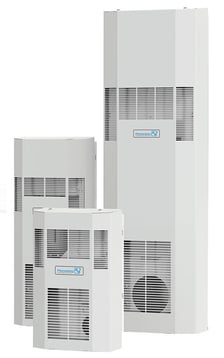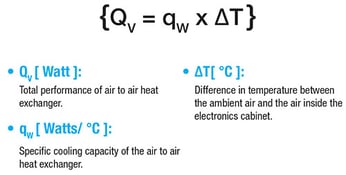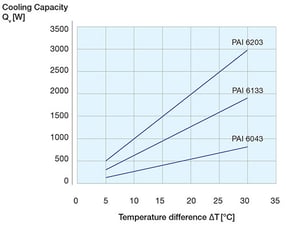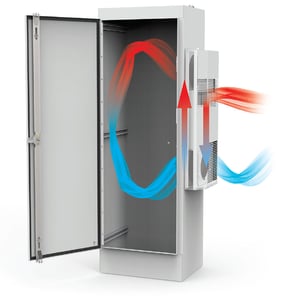Closed Loop Cooling and particularly Air to air heat exchangers are used when the complete separation between the enclosure and  the environment is required and the internal enclosure temperature to be cooled can be higher than the ambient.
the environment is required and the internal enclosure temperature to be cooled can be higher than the ambient.
The air to air units have a rating showing how much heat can be removed based on the difference in the ambient and the internal temperatures. This is traditionally rated on W/°C which is the watts of heat that the unit can remove per temperature difference in °C.
How do I know if an air to air heat exchanger is the right product for my application?
- If the ambient temperature is lower than the desired temperature inside the enclosure.
- If a total separation between ambient air and enclosure air is required.
Properly sizing an air to air heat exchanger
 To properly size an air to air heat exchanger you must know the required cooling capacity in Watts, target temperature rise over ambient and the dimensions of the heat exchanger and enclosure.
To properly size an air to air heat exchanger you must know the required cooling capacity in Watts, target temperature rise over ambient and the dimensions of the heat exchanger and enclosure.
Utilizing performance curves to properly size air/air heat exchangers:

> Pfannenberg utilizes watts of heat that the unit can remove per temperature difference in °C.
> Customers should use their own application temperatures to determine the proper cooling capacity of the system.
Important information when utilizing air/air heat exchangers: 
- The max ambient is 35 °C (95 °F) and the max internal temperature that the system can take is 45 °C (113 °F).
- Can be used when the temperature difference is 10 °C.
- If you apply this temperature difference to the rating of the air to air unit you will get the total amount of heat that can be removed.
- A unit rated 100 W/°C could remove 1000 Watts (100 x 10) of heat under these conditions.
Closed Loop Cooling with air to air heat exchangers is the most efficient cooling solution as cooling with ambient air is the most economical type of cooling!
Pfannenberg εCOOL Air to air Heat Exchangers feature an energy efficient, minimal maintenance design. Installation and maintenance of these units requires much less time compared to other closed loop Thermal Management solutions.
Click here to read the 1st part of this "Technology of Cooling" serie: Cooling with Filterfans®
Click here to read the 3rd part of this "Technology of Cooling" serie: Cooling with Closed Loop Cooling Units







